Physical Address
304 North Cardinal St.
Dorchester Center, MA 02124
Endoscopic approaches to intracranial tumors of the planum and sella are increasingly prevalent secondary to improved panoramic visualization, improved tumor resection, increased working angles, and decreased intranasal complications.
Approaches to the sphenoid planum and sella turcica require an understanding of the anatomic relationships of the sphenoid sinus, optic nerve, carotid artery, sella, planum, and clivus.
Intracranial dissection requires knowledge and experience of the normal pituitary gland and stalk, cavernous sinus, the carotid artery and its feeding vessels, including the superior and inferior hypophyseal vessels, diaphragma, and optic apparatus.
A two-surgeon technique allows for an endoscope and two dissecting instruments to be used at all times. Additionally, four-handed surgery is possible, allowing for retraction or suction while continuing dissection.
The key access to the endoscopic transphenoidal surgery of the sella and planum is wide exposure through the posterior nasal septum, both sphenoid sinuses and the ethmoid sinuses if necessary to provide access through both nares.
Reconstruction of the skull base defect with free grafts and pedicled vascularized flaps is aided by endoscopic visualization and techniques.
The natural ostium of the sphenoid sinus can be visualized by identifying and resecting the inferior third of the superior turbinate.
The sphenopalatine artery (SPA) is a terminal branch of maxillary artery and enters the nasal cavity through the sphenopalatine foramen. The SPA then bifurcates into the posterior lateral nasal artery and the posterior septal artery (PSA). The PSA traverses the rostrum of the sphenoid inferior to the natural ostium and superior to the arch of the choana, and it usually bifurcates into superior and inferior branches. Preservation of this PSA vascular pedicle is essential for a posteriorly based nasoseptal flap that can be used for skull base reconstruction.
The sella turcica is a saddle-shaped depression in the midline of the sphenoid sinus at the skull base and is the caudal aspect of the hypophyseal fossa, which contains the pituitary gland. The degree of pneumatization of the sphenoid sinus can vary. The sellar pattern results in pneumatization of the clival recess and is the most common variant ( Fig. 29.1 ).
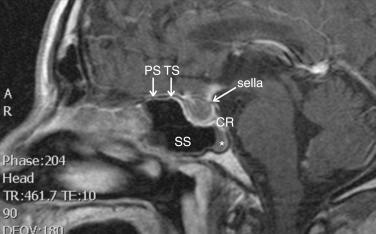
The planum sphenoidale is the roof of the sphenoid sinus that is immediately anterior to the sella turcica. The slope of the planum varies and may necessitate a posterior ethmoidectomy for improved anterior access (see Fig. 29.1 ).
The junction between the sphenoid planum and the sella turcica is the tuberculum sella. This is the approximate level of the limbus of the sphenoid, which corresponds to the axial plane of the optic nerves (see Fig. 29.1 ).
Identification of the paraclinoid carotid artery and optic nerve in the lateral aspect of the sphenoid sinus is vital on preoperative imaging and during the endoscopic approach. The lateral opticocarotid recess, a well-established landmark for these structures, is the result of pneumatization of the optic strut ( Fig. 29.2 ).
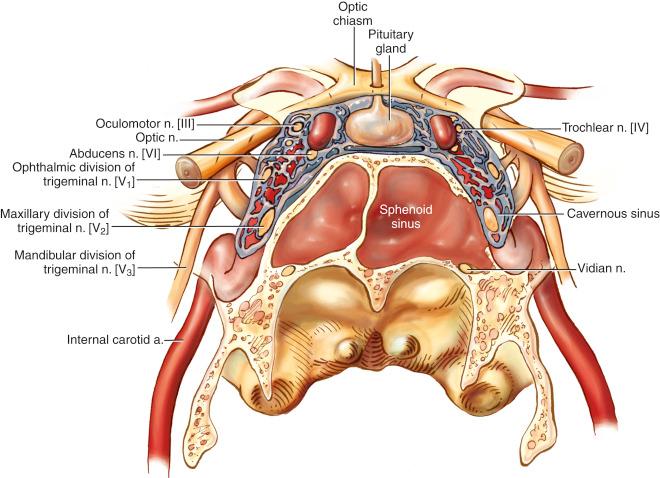
The cavernous sinuses form the lateral boundaries of the pituitary gland and are connected anteriorly by superior and inferior intracavernous sinuses ( Fig. 29.3 ). The expansile nature of macroadenomas tends to minimize intracavernous sinus vasculature. However, when operating on secreting microadenomas in normal-sized pituitary glands, these vasculature communications can result in increased bleeding.

The sella is bounded posteriorly by the dorsum sella and the posterior clinoids.
Superior to the planum sphenoidale lies intracranial vasculature that can be displaced by planum or tuberculum meningiomas and craniopharyngiomas ( Fig. 29.4 ).
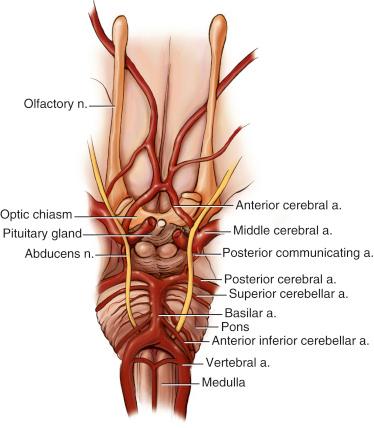
Location and size of the intracranial tumor: Determining the size and anatomic localization of the tumor is essential to providing adequate visual exposure and functional working space to allow for a safe dissection. The size and anterior extension of the tumor may need broader exposure. This would require a posterior or total ethmoidectomy, middle turbinate resection, and extended septectomy. Additionally, the size of the tumor should be considered when planning for the skull base reconstruction. A pedicled flap skull base reconstruction should be considered for tumors in which the expected defect will be large, particularly anterior skull base and clival lesions, and where the likelihood of a high-flow cerebrospinal fluid (CSF) leak is high.
Secreting pituitary tumors may increase the vascularity of the mucosa. Additionally, patients with Cushing disease may have thin nasal mucosa.
Evaluation of the nasal septum while taking note of septal deviation and nasal spurs aids in the preoperative planning of the transsphenoidal approach to the sphenoid. Significant septal deviation and nasal spurs can limit visualization of the sphenoid ostium, affect which side of the septum to use for a nasoseptal flap, and necessitate an early septectomy. Care should be taken to not incidentally injure the nasal septal mucosa, as this may be necessary for skull base reconstruction or can result in a postoperative septal perforation.
Evaluation of concurrent sinus disease and prior nasal surgeries is important. Active bacterial sinusitis may necessitate staging the procedure. A lack of septal cartilage and bone will require additional care be taken if nasoseptal flaps are raised.
Allow for adequate topical decongestion prior to initiating the surgical approach.
Use all three planes on magnetic resonance imaging (MRI) and/or computed tomography (CT) in the preoperative radiographic evaluation.
Identify the tumor and the anatomic location. Take note of any anterior and inferior extension into the sphenoid, clivus, and the ethmoid sinuses; the lateral extension and the relationship to the carotid artery; the cavernous sinuses and the temporal lobe; and the suprasellar extension, including extension into the third ventricle ( Fig. 29.5 ). The relationship of the tumor to the optic chiasm and intracerebral vasculature (anterior communicating artery and anterior cerebral arteries) should be examined ( Fig. 29.6 ).
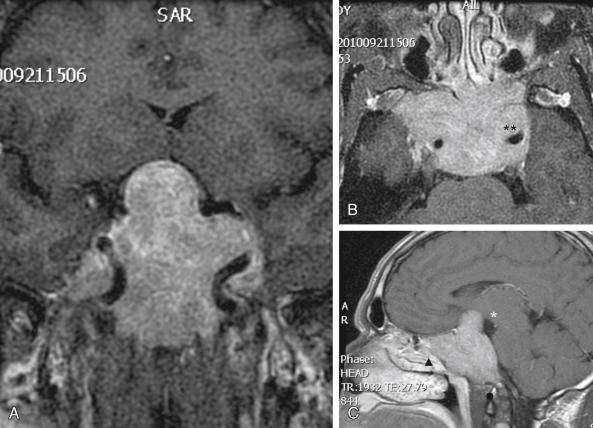
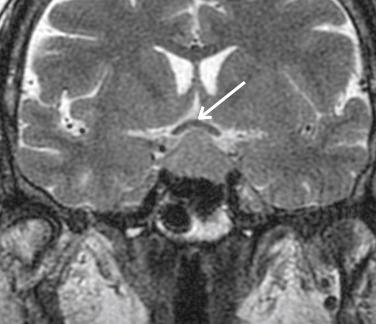
Examine the direction of the inner-sinus septum. The size of the sphenoid sinuses and the relationship of each sinus to the sella turcica should be noted. Even an appropriate sphenoidotomy into the smaller sphenoid sinus may not allow visualization of the sella if the inner-sinus septum transverses posterolaterally. Special attention to the direction of the inner-sinus septum and the carotid artery is essential. The inner-sinus septum can serve as an important intraoperative landmark. The inner-sinus septum often can be seen attaching to the bony covering of the carotid artery laterally.
Examine the pneumatization of the sphenoid sinus: Pneumatization of the sphenoid can result in lateral recesses, infrasellar pneumatization into the clival recess, a well-defined opticocarotid recess, and the potential for dehiscence of the carotid artery and optic nerve canal.
Examine pneumatization of the posterior ethmoid sinuses and vomer. Significant pneumatization of the posterior ethmoid sinuses may result in Onodi cells in direct contact with the optic nerve and displacement of the sphenoid sinus inferiorly. Pneumatization of the vomer may widen the keel appearance of the rostrum and displace the natural sphenoid os laterally.
The relationship of the planum sphenoidalis and the sella turcica is a good anatomic and radiographic landmark except when the sellar mass has significant anterior extension or the planum is distorted inferiorly.
The axial plane of the CT scan or MRI can be used to evaluate the nasal septum and inferior turbinate. Deviation of the septum and the size of the inferior turbinates may affect the surgical approach.
Intraoperative image guidance systems can be utilized as an adjunct to surgical landmarks.
0-degree and 45-degree endoscopes with possible use of lens washer

Straight, angled Beaver blade
Arachnoid knife
Curved extended Colorado tip or needle tip monopolar cautery
High-speed endoscopic drill with a diamond bur
Intraoperative Doppler
Image guidance system
Hemostatic materials (Gelfoam paste, Floseal, Surgifoam, or equivalent)
Endoscopic sinus surgery instruments and endonasal pituitary instruments should be available.
Become a Clinical Tree membership for Full access and enjoy Unlimited articles
If you are a member. Log in here